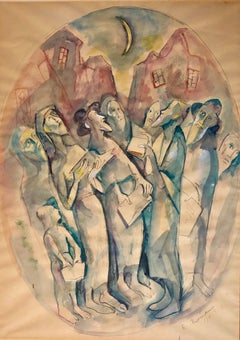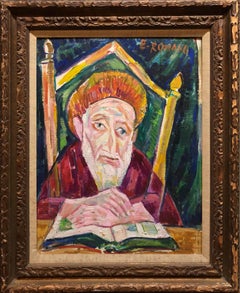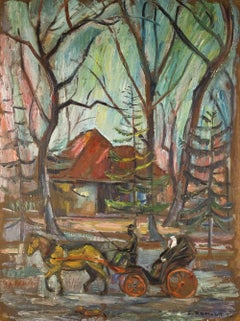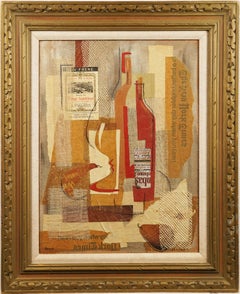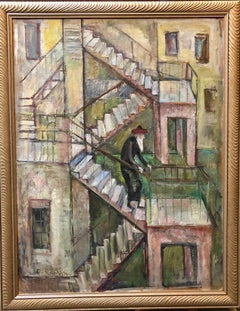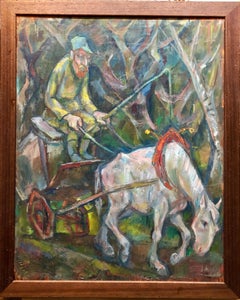Emanuel Glicenstein Romano Art
to
1
5
1
4
1
2
3
Overall Height
to
Overall Width
to
4
5
2
1
5
6,952
3,301
2,514
1,213
5
4
3
1
1
Artist: Emanuel Glicenstein Romano
Still Life (artist in Met, Chicago Art Inst., Boston MFA, Whitney, etc.)
By Emanuel Glicenstein Romano
Located in New Orleans, LA
A burst of pure delight in primary colors, by a notable artist who's been exhibited at many of America's most important museums. It was painted during the mid-century resurgence of c...
Category
Mid-20th Century Cubist Emanuel Glicenstein Romano Art
Materials
Oil
Large Modernist Oil Painting 1940s, Judaica Hasidic Shtetl Wagon Driver WPA Era
By Emanuel Glicenstein Romano
Located in Surfside, FL
Genre: Modern
Subject: Landscape with figure of horse, driver and wagon
Medium: Oil
Surface: wood Board
EMANUEL ROMANO
Rome, Italy, b. 1897, d. 1984
Emanuel Glicen Romano was born in Rome, September 23, 1897.
His father Henryk Glicenstein was a sculptor and was living in Rome with his wife Helena (born Hirszenberg) when Emanuel was born. His father obtained Italian citizenship and adopted the name Enrico. Emanuel was brought up in Italy, Switzerland, Germany, England and Poland.
In 1926 Emanuel Glicenstein Romano and his father sailed for New York. They briefly visited Chicago. Romano's sister, Beatrice, and mother only joined them in New York years later.
Romano changed his name on his arrival to America and some have erroneously speculated that this was to avoid antisemitic discrimination. In truth, as the son of a highly-regarded artist, Romano changed his name to ensure that any success or recognition he would later attain, would be the result of nothing other than his own merit as an artist, and not on account of his father's fame.
In 1936 Romano was worked for the WPA Federal Art Project creating murals. ( there were many jewish artists active with in the WPA period. notably Chaim Gross, Ben Shahn, Isaac and Moses Soyer, Abraham Rattner and many others. During and immediately after World War II, Romano created a series of allegorical works depicting graphic holocaust images that were held closely by the family until after his passing. One of these works is now on permanent display in the Florida Holocaust Museum in St. Petersburg Florida.
Emanuel's father died in 1942 in a car accident before they could realize their shared dream of visiting Israel.
In 1944 Romano, having completed his degree at the Pennsylvania Academy of Fine Arts and the Art Institute of Chicago, began teaching at the City College of New York.
Romano moved to Safed, Israel in 1953 and established an art museum in his father's memory, the Glicenstein Museum.
COLLECTIONS
Indianapolis Museum of Art
Metropolitan Museum of Art
Boston Fine Arts Museum
Fogg Museum
Musée Nacional de France
Recently his work has been added to the Florida Holocaust Museum collection. His notable works include his holocaust themed allegorical paintings as well as portraits of Marianne Moore, his father and William Carlos Williams...
Category
1930s American Modern Emanuel Glicenstein Romano Art
Materials
Oil, Board
Modernist Watercolor Painting Judaica Kiddush Levana Blessing New Moon
By Emanuel Glicenstein Romano
Located in Surfside, FL
Genre: Judaic prayer scene
Subject: Landscape
Medium: watercolor
Surface: Paper
Country: United States
EMANUEL ROMANO
Rome, Italy, b. 1897, d. 1984
Emanuel Glicenstein Romano was born in Rome, September 23, 1897.
His father Henryk Glicenstein was a sculptor and was living in Rome with his wife Helena (born Hirszenberg) when Emanuel was born his father obtained Italian citizenship and adopted the name Enrico. Emanuel was brought up in Italy, Switzerland, Germany, England and Poland.
In 1926 Emanuel and his father sailed for New York. They briefly visited Chicago. Romano's sister, Beatrice, and mother only joined them in New York years later.
Romano changed his name on his arrival to America and some have erroneously speculated that this was to avoid antisemitic anti Jewish discrimination. In truth, as the son of a highly-regarded artist, Romano changed his name to ensure that any success or recognition he would later attain, would be the result of nothing other than his own merit as an artist, and not on account of his father's fame.
In 1936 Romano was worked for the Federal Art Project creating murals. During and immediately after World War II, Romano created a series of allegorical works depicting graphic holocaust images that were held closely by the family until after his passing. One of these works is now on permanent display in the Florida Holocaust Museum in St. Petersburg Florida.
Emanuel's father died in 1942 in a car accident before they could realize their shared dream of visiting Israel.
In 1944 Romano, having completed his degree at the Pennsylvania Academy of Fine Arts and the Art Institute of Chicago, began teaching at the City College of New York.
Romano moved to Safed, Israel in 1953 and established an art museum in his father's memory, the Glicentein Museum.
COLLECTIONS
Indianapolis Museum of Art
Metropolitan Museum of Art
Boston Fine Arts Museum
Fogg Museum
Musée Nacional de France
Recently his work has been added to the Florida Holocaust Museum collection. His notable works include his holocaust themed allegorical paintings as well as portraits of Marianne Moore, his father and William Carlos Williams...
Category
20th Century American Modern Emanuel Glicenstein Romano Art
Materials
Paper, Watercolor
Modernist Oil Painting 1940s, Judaica Hasidic Rabbi in Jerusalem
By Emanuel Glicenstein Romano
Located in Surfside, FL
Genre: Portrait
Subject: Landscape
Medium: Oil
Surface: Board
Country: United States
EMANUEL ROMANO
Rome, Italy, b. 1897, d. 1984
Emanuel Glicenstein Romano was born in Rome, September 23, 1897.
His father Henryk Glicenstein was a sculptor and was living in Rome with his wife Helena (born Hirszenberg) when Emanuel was born. His father obtained Italian citizenship and adopted the name Enrico. Emanuel was brought up in Italy, Switzerland, Germany, England and Poland.
In 1926 Emanuel and his father sailed for New York. They briefly visited Chicago. Romano's sister, Beatrice, and mother only joined them in New York years later.
Romano changed his name on his arrival to America and some have erroneously speculated that this was to avoid antisemitic discrimination. In truth, as the son of a highly-regarded artist, Romano changed his name to ensure that any success or recognition he would later attain, would be the result of nothing other than his own merit as an artist, and not on account of his father's fame.
In 1936 Romano was worked for the Federal Art Project creating murals. During and immediately after World War II, Romano created a series of allegorical works depicting graphic holocaust images that were held closely by the family until after his passing. One of these works is now on permanent display in the Florida Holocaust Museum in St. Petersburg Florida.
Emanuel's father died in 1942 in a car accident before they could realize their shared dream of visiting Israel.
In 1944 Romano, having completed his degree at the Pennsylvania Academy of Fine Arts and the Art Institute of Chicago, began teaching at the City College of New York.
Romano moved to Safed, Israel in 1953 and established an art museum in his father's memory, the Glicentein Museum.
COLLECTIONS
Indianapolis Museum of Art
Metropolitan Museum of Art
Boston Fine Arts Museum
Fogg Museum
Musée Nacional de France
Recently his work has been added to the Florida Holocaust Museum collection. His notable works include his holocaust themed allegorical paintings as well as portraits of Marianne Moore, his father and William Carlos Williams...
Category
1970s American Modern Emanuel Glicenstein Romano Art
Materials
Oil, Board
LAKEWOOD N.J., 1936 Modernist Oil Painting, Judaica
By Emanuel Glicenstein Romano
Located in Surfside, FL
Genre: Modern
Subject: Landscape
Medium: Oil
Surface: Board
Country: United States
Dimensions: 30" x 22"
EMANUEL ROMANO
Rome, Italy, b. 1897, d. 1984
Emanuel Glicenstein Romano was born in Rome, September 23, 1897.
His father Henryk Glicenstein was a sculptor and was living in Rome with his wife Helena (born Hirszenberg) when Emanuel was born. His father obtained Italian citizenship and adopted the name Enrico. Emanuel was brought up in Italy, Switzerland, Germany, England and Poland.
In 1926 Emanuel and his father sailed for New York. They briefly visited Chicago. Romano's sister, Beatrice, and mother only joined them in New York years later.
Romano changed his name on his arrival to America and some have erroneously speculated that this was to avoid antisemitic discrimination. In truth, as the son of a highly-regarded artist, Romano changed his name to ensure that any success or recognition he would later attain, would be the result of nothing other than his own merit as an artist, and not on account of his father's fame.
In 1936 Romano was worked for the Federal Art Project creating murals. During and immediately after World War II, Romano created a series of allegorical works depicting graphic holocaust images that were held closely by the family until after his passing. One of these works is now on permanent display in the Florida Holocaust Museum in St. Petersburg Florida.
Emanuel's father died in 1942 in a car accident before they could realize their shared dream of visiting Israel.
In 1944 Romano, having completed his degree at the Pennsylvania Academy of Fine Arts and the Art Institute of Chicago, began teaching at the City College of New York.
Romano moved to Safed, Israel in 1953 and established an art museum in his father's memory, the Glicentein Museum.
COLLECTIONS
Indianapolis Museum of Art
Metropolitan Museum of Art
Boston Fine Arts Museum
Fogg Museum
Musée Nacional de France
Recently his work has been added to the Florida Holocaust Museum collection. His notable works include his holocaust themed allegorical paintings as well as portraits of Marianne Moore, his father and William Carlos...
Category
1930s American Modern Emanuel Glicenstein Romano Art
Materials
Oil, Board
Related Items
Antique American School Signed Framed Exhibited Cubist Still Life Oil Painting
Located in Buffalo, NY
Vintage American school signed modernist cubist still life oil painting and collage. Oil and mixed media on board. Signed. Framed. I...
Category
1950s Cubist Emanuel Glicenstein Romano Art
Materials
Canvas, Oil
H 32 in W 26 in D 2 in
1970s Abstract Figurative Framed Oil Painting, Modernist City Scene With Couple
Located in Denver, CO
1950s oil on board painting by George Cecil Carter portraying a modernist couple, thought to be Alfred Stieglitz & Georgia O'Keefe. Presented in a custom frame, outer dimensions measure 20 ⅝ x 13 ½ x 1 ⅞ inches. Image sight size is 16 ⅞ x 9 ⅞ inches.
Painting is clean and in very good vintage condition - please contact us for a complete condition report.
Provenance: Private Collection, Denver Colorado
Expedited and international shipping is available - please contact us for a quote.
About the Artist:
George Cecil Carter was born in Oklahoma in 1908 and became a noted Colorado abstract expressionist alongside contemporaries including Al Wynne, Mary Chenoweth...
Category
1950s American Modern Emanuel Glicenstein Romano Art
Materials
Oil, Board
H 20.5 in W 13.5 in D 1.75 in
Signed French Cubist Abstract Original Framed Painting
Located in Buffalo, NY
Antique French cubist abstract still life oil painting. Oil and gouache on paper. Framed. Signed Image size, 19L x 42H.
Category
1950s Cubist Emanuel Glicenstein Romano Art
Materials
Canvas, Oil
John Hatch American Cubist Landscape Oil Painting Massachusetts Seascape 1952
By John W. Hatch
Located in Buffalo, NY
An original oil on board painting by American modernist John W. Hatch. This incredible cubist landscape was created in 1952. Estate stamped and dated on the reverse. Titled, "Naha...
Category
1950s Cubist Emanuel Glicenstein Romano Art
Materials
Canvas, Oil
John Hatch American Cubist Abstract Oil Painting 1950's Mid C Black and White
By John W. Hatch
Located in Buffalo, NY
An original oil on board painting by American modernist John W. Hatch. This incredible cubist painting was created in the 1950's. Estate stamped on the reverse.
The painting com...
Category
1950s Cubist Emanuel Glicenstein Romano Art
Materials
Canvas, Oil
Crying Clown Portrait in Oil on Canvas
Located in Soquel, CA
Crying Clown Portrait in Oil on Canvas
Portrait of a sad clown by San Francisco artist John Peers (American, 1922-2009). This portrait is closely fra...
Category
1970s American Modern Emanuel Glicenstein Romano Art
Materials
Canvas, Oil
Portrait of Artist's Wife with Fruit, 1945 American Modern Oil Painting
By Hayes Lyon
Located in Denver, CO
Untitled (Portrait of Bessy Lyon, Artist Wife) is an oil on canvas painting by Hayes Lyon (1901-1987) from 1945. Presented in a wood frame, outer dimensions measure 35 ¼ x 29 ¼ x 1 ¾ inches. Image size is 30 x 24 inches.
About the Artist:
A native of Athol, Kansas, Lyon is primarily associated with Colorado. After several summer vacations at the Boulder Chautauqua and at Manitou near Colorado Springs, his family relocated in 1920 to Boulder where his father had a lumber business. Nine years later they settled in Denver where his father owned the Acme Lumber Company. To comply with his desire for his son’s financial self-reliance, Lyon graduated from the University of Colorado at Boulder in 1931 with a B.A. degree in economics.
But shortly thereafter he returned to his first love – art – that ultimately became his career. His interest in the arts was nurtured by his mother, herself a talented amateur artist, and by two of his aunts who served as role models. Beginning in 1932, he pursued a five-year course of study at the Chappell School of Art in Denver which by then had become part of the University of Denver. During his time at the school he studied with John E. Thompson and Santa Fe artist, Józef Bakoś. He also met two other Santa Fe-based artists, Willard Nash and B.J.O. Nordfeldt, when they exhibited at Chappell House, then the home of the Denver Art Museum. Lyon likewise attended the Cooke-Daniels Lecture Series there on the arts in the 1930s.
Following graduation with a B.F.A. degree from the University of Denver in 1937, he studied privately for about a year with Andrew Dasburg in Taos, New Mexico, that redirected his attention to the rugged Rocky Mountain landscape, which he saw with directness and painted with an economy of means. His canvas, Winter Vista, done following his study with Dasburg, received the Edward J. Yetter Memorial Prize at the 45th Annual Exhibition of the Denver Art Museum in 1939. The painting was reproduced in the September 1939 issue of the Magazine of Art (Washington, DC). That same year his painting, Mount Evans, was included as one of Colorado’s entries in the American Art Today Pavilion at the 1939 World’s Fair in New York.
The money he received from the Yetter Prize financed his trip to Mexico City and Guadalajara in 1939 to see firsthand the frescoes of José Clemente Orozco and Diego Rivera and the easel paintings of David Alfaro Siqueiros. Their work was admired by many Americans who participated in the WPA-era mural projects in the United States in the 1930s and early 1940s. The economic fallout from the Great Depression affecting many American artists at the time likewise resulted in Lyon’s participation in the Colorado Art Project, part of the WPA’s national program. Under its auspices he produced three murals in 1940 about the pioneer era of Fort Lupton, Colorado, which were installed in the auditorium of the local high school. Covering 367 square feet of wall space, one of the murals – Behold the West (the largest one) – incorporates the old fort for which the town is named. Before Lyon painted the murals, the students at Fort Lupton High School researched the history of their community and contributed to their cost, facilitating the murals’ allocation to their school under the Colorado Art Project.
In the early 1940s Lyon shifted his focus to two new subjects – bathers, and canyons with conifers – reflecting his ongoing search for personal artistic growth. However, his reliance on structure to create form in his paintings and works on paper alienated some of his longtime followers. Nonetheless, his painting Conifers and Canyons won recognition at the 47th Annual Exhibition at the Denver Art Museum. The watercolor version of the piece was among three hundred works in that medium selected by John Marin, Charles Burchfield and Eliot O’Hara from a national competition held by the Section of Fine Arts (Federal Works Agency) and shown at the National Gallery of Art in Washington, DC, in 1941. Later that year Lyon spent time in California where he saw Orozco’s Prometheus, influencing him to increase his range of originality and expression.
In 1942 Lyon enlisted in the U.S. Army, spending almost three years in the Mediterranean Theater – Africa and Italy – preparing camouflage operations and scale models of proposed landing sites. He used his free time in Italy to expand his artistic vocabulary by seeing cultural masterpieces in Rome, Florence, Siena and Milan, and through his extensive contact with Giorgio de Chirico, founder of the scuola metafisica art movement, and Gino Severini, a leading member of the Futurist movement. Because of Lyon’s low army rank and pay, de Chirico did a small watercolor for him signing it, "For Mr. Lyon; G de Chirico, 1944." Lyon often visited de Chirico and his wife, Isa, at their apartment near the Spanish Steps in Rome.
Following his Army discharge in 1945 fellow Kansas native, Ward Lockwood, invited him to join the Art Department at the University of Texas at Austin where he taught painting from 1946 to 1951. During this period some of Lyon’s work employed the palette of the School of Paris which he had seen while stationed in Europe, while other paintings had a certain flatness found in some of Lockwood’s work from the 1930s. From 1951 to 1953 he was affiliated with the Lower Colorado River Authority in Austin as an illustrator and editor of the employee magazine.
In 1953, following time spent in Mexico, he returned to Denver, working as an illustrator at Lowry Air Force Base until retirement in 1961. During that time he did little of his own art because he also was designing and building a home in Arvada, Colorado, and re-establishing himself in the Denver art community after a decade-long absence. His painting, Autumn Aspens (1953-present location unknown) illustrates his experimentation with abstraction.
In the early 1960s he began painting from memory that continued until the steadily degenerative effects of Alzheimer’s disease took their toll a decade later. He depicted scenes from his wartime European sojourn and from his early adulthood. The latter include Souvenir of Boulder (1962), a nostalgic return to his boyhood home in Boulder; and Holly Mayer and Friends, a painting of Glenn Miller and his musicians, inspired by Lyon’s first encounter with jazz in Boulder in the 1920s. His lifelong passion for vintage cars and automobile racing...
Category
1940s American Modern Emanuel Glicenstein Romano Art
Materials
Oil, Canvas
H 35.25 in W 29.25 in D 1.75 in
"Industrial Cityscape, Chicago" WPA Modernism Mid-Century Cityscape 20th Century
By Aaron Bohrod
Located in New York, NY
Midwestern Chicago artist Aaron Bohrod painted in 1931 this modernist industrial cityscape during the WPA of the 20th Century.
Aaron Bohrod (American 1907 – 1992), Industrial Citysc...
Category
1930s American Modern Emanuel Glicenstein Romano Art
Materials
Oil, Board
"The Arno" Italian Village by the River Oil Painting by Bruce McCracken
Located in Pasadena, CA
This oil painting from the 65s by California Artist Bruce McCracken derives its title and inspiration from the mythical Arno River in Tuscany. Dividing the historic city of Florence into two distinct parts, the Arno has long captivated the collective imagination and continues to be a subject of exploration for many contemporary artists.
Set against the backdrop of the Arno's picturesque banks, the artist likely sought inspiration from the vantage point of the Ponte Vecchio (Old Bridge) in Florence. The painting is divided into two distinct horizons. The upper section showcases architectural buildings poised upon a medieval arch...
Category
1960s American Modern Emanuel Glicenstein Romano Art
Materials
Board, Oil
H 41.38 in W 49.38 in D 1.5 in
Vintage American School Modernist Guitar Cubist Abstract Musical Still Life
Located in Buffalo, NY
Vintage signed American school guitar still life oil painting. Oil on canvas. Signed illegibly. Framed. Image size, 22L x 18H.
Category
1950s Cubist Emanuel Glicenstein Romano Art
Materials
Canvas, Oil
H 24 in W 28 in D 2 in
A Pair of Modern Impressionist Landscape Oil Paintings Framed Female artist NY
Located in Buffalo, NY
A Pair of Modernist Landscapes by listed female artist Margaret Munro Stratton McLennan.
Margaret was a painter working in the early 20th Century in the Syracuse area. These charmi...
Category
1920s American Modern Emanuel Glicenstein Romano Art
Materials
Board, Oil
Mid Century Sitting Nude Figurative
By Elmer Albritton
Located in Soquel, CA
Mid Century figurative painting of a pensive sitting nude figure with moody, mid-century color palette in the background. Attributed to Elmer S. Albritton, unsigned (American, 1922-...
Category
1960s American Modern Emanuel Glicenstein Romano Art
Materials
Canvas, Oil, Cardboard
Previously Available Items
Large Modernist Oil Painting 1940s, Judaica Hasidic rabbi in Jerusalem
By Emanuel Glicenstein Romano
Located in Surfside, FL
Genre: Modern
Subject: Landscape
Medium: Oil
Surface: Board
Country: United States
EMANUEL ROMANO
Rome, Italy, b. 1897, d. 1984
Emanuel Glicenstein Romano was born in Rome, September 23, 1897.
His father Henryk Glicenstein was a sculptor and was living in Rome with his wife Helena (born Hirszenberg) when Emanuel was born. His father obtained Italian citizenship and adopted the name Enrico. Emanuel was brought up in Italy, Switzerland, Germany, England and Poland.
In 1926 Emanuel and his father sailed for New York. They briefly visited Chicago. Romano's sister, Beatrice, and mother only joined them in New York years later.
Romano changed his name on his arrival to America and some have erroneously speculated that this was to avoid antisemitic discrimination. In truth, as the son of a highly-regarded artist, Romano changed his name to ensure that any success or recognition he would later attain, would be the result of nothing other than his own merit as an artist, and not on account of his father's fame.
In 1936 Romano was worked for the Federal Art Project creating murals. During and immediately after World War II, Romano created a series of allegorical works depicting graphic holocaust images that were held closely by the family until after his passing. One of these works is now on permanent display in the Florida Holocaust Museum in St. Petersburg Florida.
Emanuel's father died in 1942 in a car accident before they could realize their shared dream of visiting Israel.
In 1944 Romano, having completed his degree at the Pennsylvania Academy of Fine Arts and the Art Institute of Chicago, began teaching at the City College of New York.
Romano moved to Safed, Israel in 1953 and established an art museum in his father's memory, the Glicentein Museum.
COLLECTIONS
Indianapolis Museum of Art
Metropolitan Museum of Art
Boston Fine Arts Museum
Fogg Museum
Musée Nacional de France
Recently his work has been added to the Florida Holocaust Museum collection. His notable works include his holocaust themed allegorical paintings as well as portraits of Marianne Moore, his father and William Carlos Williams...
Category
1930s American Modern Emanuel Glicenstein Romano Art
Materials
Oil, Board
Large Modernist Oil Painting 1940s, Judaica Hasidic Shtetl Wagon Driver WPA Era
By Emanuel Glicenstein Romano
Located in Surfside, FL
Genre: Modern
Subject: Landscape with figure of horse, driver and wagon
Medium: Oil
Surface: wood Board
EMANUEL ROMANO
Rome, Italy, b. 1897, d. 1984
Emanuel Glicen Romano was born...
Category
1930s American Modern Emanuel Glicenstein Romano Art
Materials
Oil, Board
Modernist Watercolor Painting Judaica Kiddush Levana Blessing New Moon
By Emanuel Glicenstein Romano
Located in Surfside, FL
Genre: Judaic prayer scene
Subject: Landscape
Medium: watercolor
Surface: Paper
Country: United States
EMANUEL ROMANO
Rome, Italy, b. 1897, d. 1984
Emanuel Glicenstein Romano was bo...
Category
20th Century American Modern Emanuel Glicenstein Romano Art
Materials
Paper, Watercolor
Modernist Oil Painting 1940s, Judaica Hasidic Rabbi in Jerusalem
By Emanuel Glicenstein Romano
Located in Surfside, FL
Genre: Portrait
Subject: Landscape
Medium: Oil
Surface: Board
Country: United States
EMANUEL ROMANO
Rome, Italy, b. 1897, d. 1984
Emanuel Glicenstein Romano was born in Rome, Septem...
Category
1970s American Modern Emanuel Glicenstein Romano Art
Materials
Oil, Board
Two Cats
By Emanuel Glicenstein Romano
Located in Milford, NH
Modernist abstract oil painting titled "Two Cats" created in 1958 by Emanuel Glicenstein Romano (1896-1984). Oil on board, signed lower left, label en verso. ...
Category
Mid-20th Century Abstract Emanuel Glicenstein Romano Art
Materials
Oil, Panel
Large Modernist Oil Painting 1940s, Judaica Hasidic rabbi in Jerusalem
By Emanuel Glicenstein Romano
Located in Surfside, FL
Genre: Modern
Subject: Landscape
Medium: Oil
Surface: Board
Country: United States
EMANUEL ROMANO
Rome, Italy, b. 1897, d. 1984
Emanuel Glicenstein Romano was born in Rome, Septembe...
Category
1930s American Modern Emanuel Glicenstein Romano Art
Materials
Oil, Board
LAKEWOOD N.J., 1936 Modernist Oil Painting, Judaica
By Emanuel Glicenstein Romano
Located in Surfside, FL
Genre: Modern
Subject: Landscape
Medium: Oil
Surface: Board
Country: United States
Dimensions: 30" x 22"
EMANUEL ROMANO
Rome, Italy, b. 1897, d. 1984
Emanuel Glicenstein Romano was...
Category
1930s American Modern Emanuel Glicenstein Romano Art
Materials
Oil, Board
Emanuel Glicenstein Romano art for sale on 1stDibs.
Find a wide variety of authentic Emanuel Glicenstein Romano art available for sale on 1stDibs. You can also browse by medium to find art by Emanuel Glicenstein Romano in paint, oil paint, board and more. Much of the original work by this artist or collective was created during the 20th century and is mostly associated with the modern style. Not every interior allows for large Emanuel Glicenstein Romano art, so small editions measuring 22 inches across are available. Customers who are interested in this artist might also find the work of William Harnden, Arnold Blanch, and Alfred Wands. Emanuel Glicenstein Romano art prices can differ depending upon medium, time period and other attributes. On 1stDibs, the price for these items starts at $1,800 and tops out at $6,500, while the average work can sell for $3,900.


